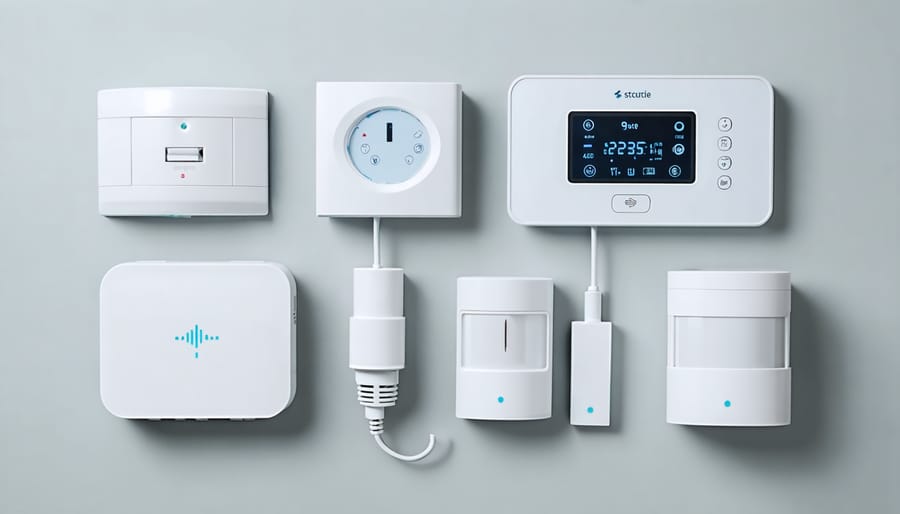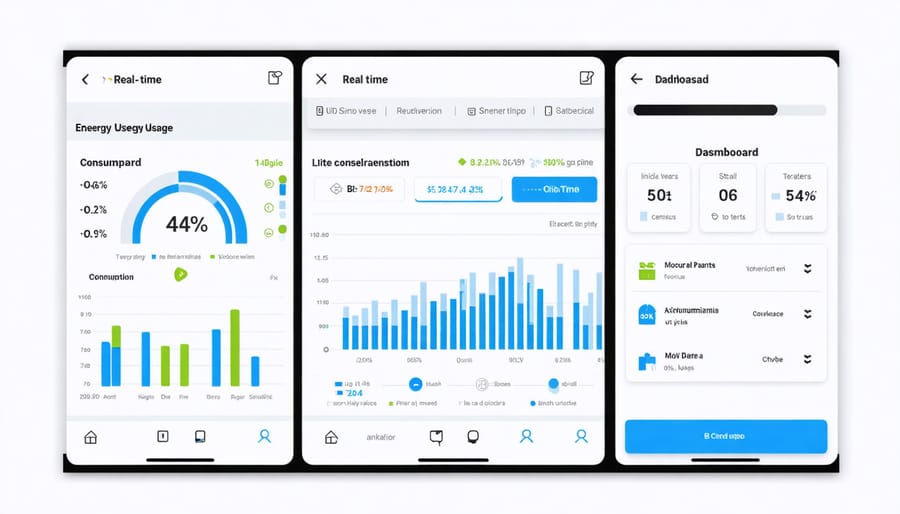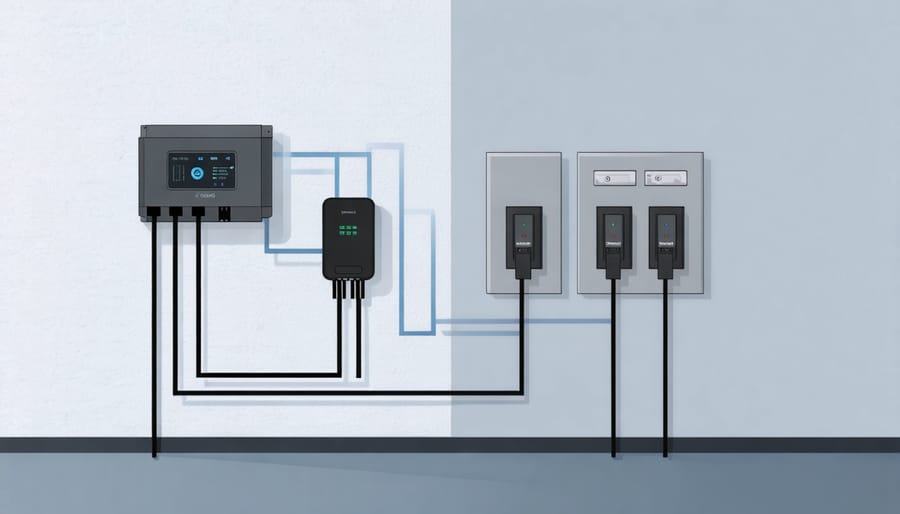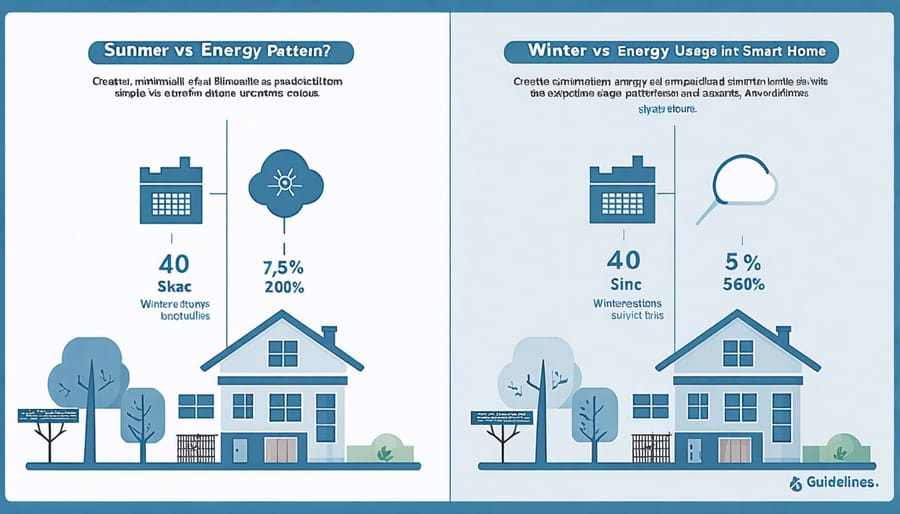Transform your home into an energy-efficient powerhouse with smart monitoring systems that put real-time power consumption data at your fingertips. Today’s intelligent energy monitors do more than track usage—they identify energy-draining appliances, alert you to unusual consumption patterns, and provide personalized recommendations that can slash your monthly bills by up to 30%.
Imagine knowing exactly which devices are consuming excess power and when, allowing you to make informed decisions about your energy usage. Modern smart monitoring systems integrate seamlessly with your smartphone, giving you instant notifications about energy spikes and detailed insights into your consumption patterns. Whether you’re at home or away, you maintain complete visibility and control over your home’s energy profile.
Beyond the immediate cost savings, these systems represent a significant step toward sustainable living. By understanding and optimizing your energy usage, you’re not just reducing your carbon footprint—you’re future-proofing your home against rising energy costs. With utility prices continuing to climb, investing in smart energy monitoring has never made more sense for the environmentally conscious homeowner.
Ready to take control of your home’s energy consumption? Let’s explore how these innovative systems can revolutionize your approach to power management and help you build a more efficient, sustainable home.
How Smart Energy Monitoring Systems Work
Core Components
At the heart of every smart home energy monitoring system are three essential components that work together to give you a complete picture of your energy usage. Let’s explore these key elements that make energy monitoring possible and effective.
First up are the sensors, which act like tiny energy detectives throughout your home. These compact devices attach to your electrical panel or individual appliances, measuring electricity flow in real-time. You’ll find both whole-house sensors that track total energy consumption and individual smart plugs that monitor specific devices.
Smart meters are the next crucial piece of the puzzle. These modern replacements for traditional electric meters communicate directly with your utility company and your monitoring system. They provide detailed data about your energy usage patterns, peak consumption times, and even power quality. Many utility companies now offer smart meter upgrades at no additional cost.
The monitoring hub or gateway device ties everything together. This central brain of your energy monitoring system collects data from all sensors and smart meters, processes it, and presents it in an easy-to-understand format through a smartphone app or web interface. The best monitoring devices can track multiple energy sources, including solar panels if you have them, and provide customizable alerts when usage spikes occur.
These components create a comprehensive system that helps you understand and optimize your home’s energy consumption, ultimately leading to smarter energy choices and lower utility bills.

Data Collection and Analysis
Your smart home energy monitoring system works like a vigilant energy detective, constantly gathering and analyzing data about your home’s power consumption. The system typically connects to your main electrical panel through current transformer sensors, which safely measure the electricity flowing through your circuits without any direct electrical contact.
These sensors capture real-time data about your energy usage, typically taking readings every few seconds. The information is then transmitted to a central hub or gateway device, usually through wireless protocols like Wi-Fi or Zigbee. This continuous stream of data helps create a detailed picture of your home’s energy patterns.
The system’s smart algorithms process this raw data into meaningful insights. They can identify which appliances are running based on their unique energy signatures, track usage patterns throughout the day, and even detect unusual spikes that might indicate problems with specific devices.
The processed information is presented to you through user-friendly mobile apps or web dashboards. You’ll see easy-to-understand charts and graphs showing your energy consumption by hour, day, or month. Many systems also provide predictive analytics, helping you forecast future energy bills and suggesting ways to optimize your usage.
The best part? All this happens automatically in the background, giving you actionable insights without any manual tracking or calculations on your part.
Benefits for Your Home and Wallet
Real-Time Energy Usage Insights
Real-time energy monitoring transforms the way you understand and manage your home’s power consumption. Instead of waiting for monthly surprises in your utility bill, you get instant feedback on where and how your energy is being used. This valuable information helps you spot energy-hungry appliances and identify wasteful habits you might not even realize you have.
Think of it as having a personal energy detective in your home. Your smart monitoring system creates detailed usage patterns that show exactly when your energy consumption peaks and valleys occur. For example, you might discover your dryer is using more electricity than necessary, or your HVAC energy optimization could use some attention.
These systems typically display data through user-friendly apps or dashboards, making it easy to spot trends. You might notice that your energy usage spikes between 6-8 PM when everyone’s home, cooking dinner, and running appliances. Armed with this knowledge, you can make simple adjustments like running your dishwasher during off-peak hours or adjusting your thermostat settings.
The real magic happens when you start acting on these insights. Many homeowners report saving 10-30% on their energy bills simply by addressing the inefficiencies their monitoring systems reveal. Whether it’s unplugging energy-vampire devices, upgrading to more efficient appliances, or changing daily habits, your smart monitoring system helps you make informed decisions that lead to real savings.
Remember, you can’t manage what you can’t measure. Real-time monitoring puts you in control of your home’s energy story, helping you create a more efficient and cost-effective living space.

Cost Reduction Strategies
Once you’ve gathered data from your smart home energy monitoring system, putting it to work is where the real savings begin. Let’s explore practical strategies to transform those insights into lower energy bills.
Start by identifying your energy consumption patterns. Look for peak usage times and adjust your routines accordingly. For instance, running your dishwasher or doing laundry during off-peak hours can lead to significant savings, especially if your utility company offers time-of-use rates.
Take advantage of AI-powered energy savings features that automatically adjust your home’s settings based on your usage patterns. These smart systems can optimize your HVAC schedule, dim lights in unused rooms, and even power down devices that aren’t in use.
Create customized alerts for unusual energy spikes. This helps you catch energy-hungry appliances or forgotten devices that might be driving up your bills. For example, set notifications for when your energy usage exceeds your daily average by 20% or more.
Use your monitoring data to establish a baseline for your home’s energy consumption, then set realistic reduction goals. Start with a modest target, like reducing your energy use by 10% in the first month. As you achieve these goals, gradually increase your targets.
Consider implementing zone-based controls for heating and cooling. By monitoring temperature data room by room, you can adjust settings to avoid heating or cooling unused spaces while maintaining comfort in frequently used areas.
Remember to regularly review your energy reports and adjust your strategies as seasons change. What works in summer might need tweaking for winter efficiency.
Setting Up Your Monitoring System
Choosing the Right System
When selecting a smart home energy monitoring system, several key factors can help you make the right choice for your needs. First, consider the compatibility with your existing electrical setup and smart home ecosystem. Some systems work seamlessly with popular platforms like Google Home or Amazon Alexa, while others may have standalone apps.
Your budget is another crucial consideration. While basic monitors start around $50, more comprehensive systems with advanced features can range significantly higher. Understanding energy monitoring system costs upfront will help you make an informed decision that balances features with affordability.
Look for systems that offer real-time monitoring and detailed energy consumption breakdowns. The ability to track individual appliances can be particularly helpful in identifying energy hogs. Also, consider whether you want a DIY installation or professional setup – some systems are plug-and-play, while others require electrical work.
Data accessibility is equally important. Choose a system with an intuitive interface and useful reporting features. Mobile app support, email alerts, and customizable dashboards can make it easier to track and adjust your energy usage on the go.
Finally, check for additional features like solar integration capability, battery backup, and firmware update support. These features might not be essential now but could become valuable as your smart home needs evolve.

Installation Steps
Installing a smart home energy monitoring system can be done either as a DIY project or with professional help. For DIY installation, start by turning off your home’s main power at the circuit breaker – safety first! Next, locate your electrical panel and remove the panel cover carefully.
Install the current transformers (CTs) by clipping them around your main power lines. These donut-shaped sensors measure your electricity flow without direct electrical contact. Connect the CTs to your monitoring hub following the manufacturer’s color-coding guide.
Mount your system’s hub near the electrical panel, ensuring it’s within your Wi-Fi range. Most systems come with mounting brackets and screws. Connect the voltage sensors to your circuit breaker following the included instructions, then restore power to test the connection.
Download your system’s smartphone app and follow the setup wizard to connect your hub to your home network. The app will guide you through naming circuits and setting up monitoring preferences.
If you’re not comfortable working with electrical systems, professional installation is highly recommended. Most electricians can complete the installation in 1-2 hours, typically charging between $100-300. Many manufacturers also offer certified installers who are specifically trained with their systems.
Remember to check local regulations, as some areas require licensed electricians for any electrical work. Whether DIY or professional, proper installation ensures accurate monitoring and safe operation of your system.
Configuration and App Setup
Setting up your smart home energy monitoring system is easier than you might think! Start by finding the perfect spot to install your monitoring hub – ideally near your electrical panel and within range of your home’s Wi-Fi network. Most systems come with straightforward mounting hardware and clear instructions for a hassle-free installation.
Once mounted, download your system’s companion app to your smartphone and create an account. The app will guide you through the connection process, typically involving scanning a QR code on the device or entering a unique system ID. Make sure your phone is connected to your home Wi-Fi network during setup, as you’ll need to share these credentials with your monitoring system.
Next, configure your preferences within the app. This includes setting up your utility rate structure, establishing baseline energy usage patterns, and customizing alerts. Take time to explore features like real-time monitoring, custom notifications for usage spikes, and energy-saving recommendations.
For optimal performance, consider these pro tips:
– Position sensors away from large metal objects that might interfere with signals
– Test your Wi-Fi signal strength at the installation location before mounting
– Set up different zones or circuits to track specific appliances
– Enable automatic updates to ensure you always have the latest features
– Take advantage of the tutorial sections in your app to discover all available features
Remember to keep your system’s firmware updated and regularly check that all connections are secure for consistent monitoring.
Making the Most of Your Energy Monitor
Daily Monitoring Habits
Developing consistent monitoring habits is key to making the most of your smart home energy monitoring system. Start your day by checking your morning energy usage – this quick glance can reveal if any devices were accidentally left running overnight. Many homeowners find it helpful to set specific times for checking their energy dashboard, such as after breakfast and before bedtime.
Create a routine of reviewing your weekly energy reports every Sunday evening. This helps you spot patterns and adjust your habits accordingly. Pay special attention to peak usage times and unusual spikes, which might indicate inefficient appliances or behavioral patterns that need addressing.
Make use of your system’s mobile app notifications. Set up alerts for when energy consumption exceeds your predetermined thresholds – this real-time feedback helps you take immediate action. Consider keeping a simple energy journal for the first month, noting activities that correspond with higher usage periods.
Get your family involved by making energy monitoring a group activity. Turn it into a friendly competition to see who can reduce their energy usage the most. Children especially enjoy tracking their progress through colorful app interfaces and celebrating when the family reaches energy-saving goals.
Remember to regularly check your appliance-specific data. This breakdown helps you identify which devices are energy hogs and when they’re consuming the most power. Monthly comparisons of your energy data will show if your monitoring habits are paying off through reduced consumption and lower utility bills.

Seasonal Adjustments
Just like your wardrobe, your home’s energy needs change with the seasons, and your smart monitoring system should adapt accordingly. Let’s explore how to optimize your energy monitoring throughout the year for maximum efficiency and comfort.
During summer months, focus your monitoring on air conditioning usage patterns. Set your system to track peak cooling times and adjust schedules around the hottest parts of the day. Many smart systems can automatically increase temperature settings when you’re away and cool your home just before you return, leading to significant savings.
Winter brings its own set of challenges. Configure your system to monitor heating efficiency and identify any unusual spikes in energy consumption that might indicate drafts or insulation problems. Smart thermostats can work with your monitoring system to maintain comfort while preventing energy waste during those cold months.
Spring and fall are ideal times to review your annual energy data and make adjustments to your monitoring strategies. These transition seasons offer perfect opportunities to test new energy-saving approaches and work toward zero-energy home solutions.
Consider setting seasonal benchmarks in your monitoring system. For example, establish different baseline consumption levels for each season and set up alerts when usage exceeds these thresholds. This proactive approach helps you stay on top of energy use year-round while maintaining comfort in your home.
Remember to review and update your automation rules quarterly. What works in July might not be ideal in December, so keeping your system’s settings aligned with seasonal changes ensures optimal performance and efficiency throughout the year.
Taking control of your home’s energy consumption has never been more accessible or rewarding than it is today. Smart home energy monitoring systems represent a significant step forward in managing your household’s energy usage, putting the power of information and control right at your fingertips.
By implementing a smart energy monitoring system, you’re not just installing another gadget – you’re making a conscious decision to understand and optimize your home’s energy consumption. The benefits we’ve explored, from real-time usage tracking to substantial cost savings and environmental impact reduction, make these systems a worthwhile investment for any modern household.
Remember that starting small is perfectly fine. You might begin with a basic monitoring system and gradually expand its capabilities as you become more comfortable with the technology. The key is to choose a system that matches your needs and comfort level while providing room for future growth.
The path to energy efficiency doesn’t have to be complicated or overwhelming. With today’s user-friendly interfaces and straightforward installation processes, most homeowners can get started without professional help. However, don’t hesitate to seek professional assistance if you’re unsure about any aspect of the setup.
As energy costs continue to rise and environmental concerns grow, smart home energy monitoring systems will become increasingly essential in modern homes. By taking this step now, you’re not just preparing for the future – you’re actively shaping it. Start your journey toward smarter energy management today, and join the growing community of homeowners who are taking control of their energy consumption while contributing to a more sustainable future.
